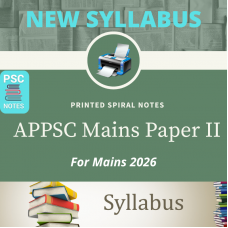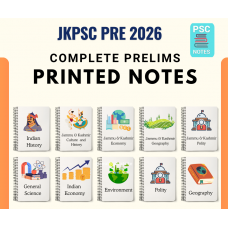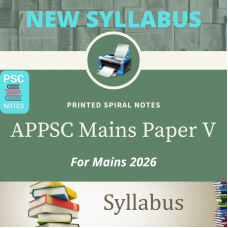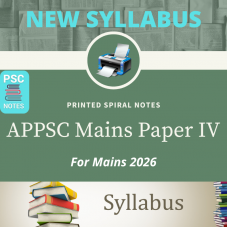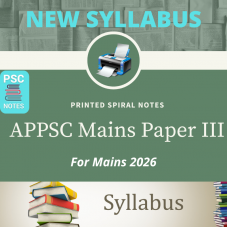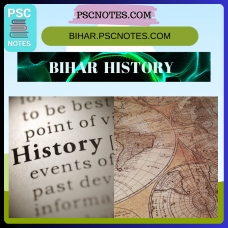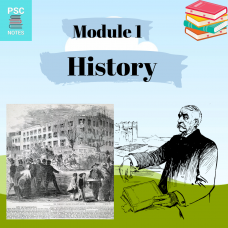Conquer APPSC Mains Paper 2 with Unparalleled Clarity and Comprehensive Coverage!
Are you meticulously preparing for the demanding APPSC Mains examination, specifically targeting Paper 2? Do you find yourself sifting through mountains of material, struggling to identify the most crucial concepts and synthesize them into a coherent understanding? Then look no further! Introducing the APPSC Mains Printed Spiral Binded Notes Paper 2, your definitive companion for mastering this vital section of the exam. This meticulously crafted resource is designed to equip you with the knowledge, clarity, and confidence you need to excel and secure your desired rank.
What Makes Our Notes Stand Apart?
We understand that effective preparation hinges on high-quality study material. That's why our APPSC Mains Printed Spiral Binded Notes Paper 2 are not just a compilation of facts, but a strategically structured learning tool. Each page has been thoughtfully designed to be easily digestible, visually appealing, and packed with the essence of what the APPSC exam demands for Paper 2.
Key Features That Will Elevate Your Preparation:
- Comprehensive Coverage: We leave no stone unturned. Our notes meticulously cover the entire syllabus for APPSC Mains Paper 2, ensuring you have access to all the essential topics and sub-topics required. From in-depth analysis of specific subjects to the nuances of critical thinking, everything is presented in a systematic manner.
- Printed Perfection: Say goodbye to the squinting and eye strain associated with poorly printed or handwritten notes. Our notes are professionally printed with clear, crisp fonts and optimal spacing, making extended study sessions comfortable and productive.
- Durable Spiral Binding: The robust spiral binding allows for effortless page-turning, lying flat on your desk for convenient note-taking and quick referencing. No more wrestling with pages that refuse to stay open! This practical binding ensures your notes remain intact throughout your rigorous preparation journey.
- Concept-Driven Approach: We go beyond rote memorization. Our notes emphasize conceptual clarity, breaking down complex ideas into simple, understandable terms. We believe that a strong grasp of underlying principles is the key to answering application-based questions effectively.
- Concise and Relevant Content: In the race against time, brevity is a virtue. We have distilled vast amounts of information into precise, concise notes, highlighting the most probable exam-relevant points. This ensures you focus on what truly matters, optimizing your study time.
- Logical Flow and Structure: Each topic is presented with a logical progression, building your understanding incrementally. This structured approach facilitates easy comprehension and retention, allowing you to connect different pieces of information seamlessly.
- Exam-Oriented Focus: Designed with the APPSC Mains examination pattern in mind, our notes are tailored to address the specific question types and depth of knowledge expected in Paper 2. We've incorporated insights into how topics are often tested, giving you a strategic advantage.
The Unbeatable Benefits of Choosing Our Notes:
Investing in the APPSC Mains Printed Spiral Binded Notes Paper 2 means investing in your success. Here’s how they directly translate into tangible benefits for your preparation:
- Time Efficiency: By providing pre-digested, well-organized information, our notes significantly reduce your research and compilation time, allowing you to dedicate more hours to active learning and practice.
- Enhanced Retention: The clear, concise, and concept-driven presentation aids in better understanding and, consequently, superior retention of information. You'll find yourself recalling facts and theories more readily during the exam.
- Increased Confidence: As you work through our structured notes, you'll witness a marked improvement in your comprehension and command over Paper 2 topics. This burgeoning knowledge directly translates into increased confidence when facing the examination hall.
- Targeted Preparation: Our notes eliminate guesswork by focusing on the most crucial aspects of Paper 2. This targeted approach ensures you are well-prepared for the specific demands of the exam, avoiding wasted effort on less important material.
- Convenient Revision Tool: The spiral binding and organized layout make these notes an ideal tool for quick and effective revision, especially in the crucial days leading up to the examination.
Who Will Benefit Most?
This resource is tailor-made for aspiring candidates appearing for the APPSC Mains examination, specifically focusing on Paper 2. Whether you are a fresh graduate embarking on your civil services journey or an experienced aspirant looking to refine your preparation, these notes offer substantial value. They are particularly beneficial for:
- Candidates who find it challenging to synthesize information from multiple sources.
- Those who prefer tangible, printed study material over digital resources.
- Individuals seeking a structured and organized approach to their preparation.
- Students who want to maximize their study efficiency and focus on exam-relevant content.
Don't let APPSC Mains Paper 2 be a hurdle. Make it your stepping stone to success with the APPSC Mains Printed Spiral Binded Notes Paper 2. Order yours today and embark on a confident, well-prepared journey towards your dream career!
If you Purchase Digital Products ,they could be accesses after the final Payment from:-
Home >>>Account >>> My Orders >>> Downloads
If you purchase Printed Notes, Our Printed orders are shipped within 2 working days of the order, and delivered in 2-7 days from shipping. We ship through leading courier services and aggregators, and you can track your order status after it is shipped. In the event where we are unable to deliver any items in your order or your entire order, be assured that you will not be charged for the item/order or you shall be refunded for the full item/order cost.
If you purchase Test Series, Test series are furnished through students portal within 24-48 Hours of successfull payment.


